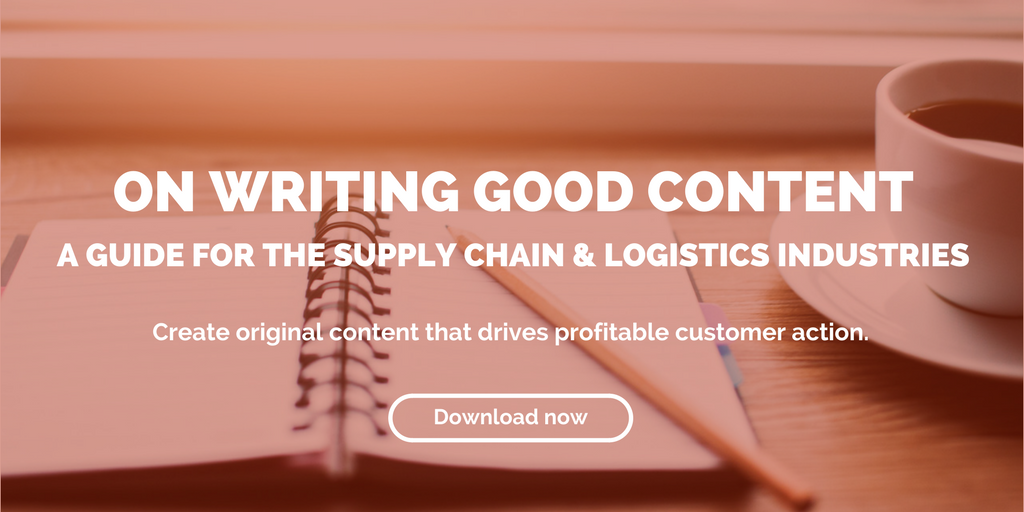
by Fronetics | Feb 6, 2019 | Blog
Digital marketing has become essential to creating brand awareness, educating audiences and building credibility with customers. Here are the latest trends for 2019.
Highlights:
- Digital marketing has become essential to creating brand awareness, educating audiences and building credibility and trust with customers.
- Video is currently the most popular form of content being consumed online today.
- Peers and colleagues are the third most influential source of information for business to business (B2B) purchasing, right behind online searches and your website.
Video transcript:
Hi I’m Stacia Pathiakis. I’m an account manager at Fronetics and today I’ll going to be talking to you about six trends in digital marketing for the supply chain in 2019.
Digital marketing has become essential for creating brand awareness, educating audiences and building trust and credibility with your customers. Supply chain and logistics companies increasingly see the value in digital marketing. They’re increasing their budgets and it’s important to understand what the trends are for the upcoming year.
Here are six trends to consider when planning your 2019 strategy.
First, video. Video is currently the most popular form of content being consumed online today, and video marketing will continue to add substantial value in the upcoming year. Use video to teach your audience something that is worthwhile for them to know.
- Chatbots. Chatbots are automated messaging apps that simulate human conversation. They’ve become more popular in the past year than social networks.
- Voice search. Voice search is becoming an increasingly prevalent. It’s a means for people to search for the content they’re looking for using voice recognition. A good content marketing strategy should consider how your customers will be using voice search for information about in your industry.
Next is long-form content. Long form content includes such things as white papers, case studies, and longer form blog posts. Many industries, including supply chain and logistics industries, are saturated with short form content. Long form content provides a means of getting more in-depth information to your customers.
- Brand ambassadors. Peers and colleagues are the third most influential source of information for business to business (B2B) purchasing. And there’s nothing more credible than a friend who speaks highly of their company’s services and products.
- Market influencers. Market influencers is a form of marketing that focuses on individuals rather than the market as a whole. Basically, marketers identify individuals who would have influence over a larger group and target them specifically in their digital marketing campaign.
The beginning of the year is a great time to review your marketing strategy to make any changes for the upcoming year. For more tips on boosting your digital marketing strategy in 2019, visit us at fronetics.com.
Related posts:


by Elizabeth Hines | Dec 6, 2018 | Blog, Content Marketing, Current Events, Logistics, Marketing, Social Media, Strategy, Supply Chain
As content marketing continues to increase in popularity, here are six trends to consider when planning your 2019 strategy.
A recent article by Forbes on content marketing notes: “As recently as a few years ago, marketers handled content mostly as a side project. It was more of a bonus than an essential role — something you did when you had time because it took a backseat to more traditional marketing projects and responsibilities. That’s changed.”
Boy, has that changed. The content marketing industry is expected to be worth more than $400 billion by 2021.
The 2018 report from the Content Marketing Institute shows just how prevalent content marketing is, and how essential it has become to creating brand awareness, educating your audience, and building credibility and trust with your customers.
Supply chain & logistics marketers: Trends to watch
So, where is content marketing headed in 2019? Content marketing budgets are still on the rise, and supply chain and logistics companies are increasingly seeing the value in moving to an inbound marketing strategy driven by original content.
These are the six notable trends to consider when planning your 2019 content marketing strategy.
1. Video
Video is currently the most popular form of content being consumed online today, and video marketing will continue to have substantial value in 2019.
Smart supply chain marketers should start the new year by developing a visual storytelling strategy that offers consistent delivery of valuable content.
What’s your best bet? Be helpful and teach your audience something worthwhile to them.
2. Chatbots
The rise of chatbots – automated computer programs that simulate human conversation in messaging apps – is expected to continue in 2019. Business Insider recently reported that the number of people on messaging apps surpassed the number of users on social networks!
[bctt tweet=”Business Insider recently reported that the number of people on messaging apps surpassed the number of users on social networks!” username=”Fronetics”]
Chatbots are just one of the ways artificial intelligence will shape the content marketing landscape in 2019, but their ability to drastically increase customer engagement puts them on the short list for a major trend to watch in the coming year.
3. Voice search
Voice search is becoming an increasingly prevalent means of attaining information. Statistics vary, but it’s expected that anywhere between 30-50% of all searches will be voice searches by 2020. A recent report by NPR and Edison Research found that the rise of smart speakers is substantially changing consumer routines and purchasing behavior.
A good content marketing strategy for 2019 should consider how your customers might use voice search in your industry, and what you can do to maximize your content’s ability to respond.
4. Long-form content
I love this one, because it harkens back to humble beginnings of content marketing and the desire to put informative, quality content in front of a targeted interested audience.
Long form content – white papers, case studies, and lengthier blog posts e.g. – will have a resurgence of renewed appreciation in 2019. Why? Because many industries, including supply chain and logistics industries, are saturated with tons of mediocre short form content. People are increasingly looking to weed through it all for substantial quality posts from trusted sources. In addition, search engines will favor longer posts in results rankings.
Cheers to 2019 being the year of quality over quantity!
5. Brand ambassadors
We wrote about brand ambassadors as we headed into 2018, but they are worth mentioning again as we look forward to 2019. Brand ambassadors are employees that influence the B2B buying decisions of others, and they are an often-overlooked resource with more traditional marketing tactics.
Peers and colleagues are the third most influential source of information for business to business (B2B) purchasing, right behind online searches and your website! And there’s nothing more credible than a friend who speaks highly of their company’s product or service.
Definitely consider how you can help make brand ambassadors out of your employees in 2019.
6. Market Influencers
The final trend to watch in 2019 is influencer marketing, a form of marketing which focuses on influential people rather than the market as a whole.
Basically, marketers identify individuals who might have influence over potential buyers and create marketing campaigns and activities around these influencers. In many ways, this works similarly to a brand ambassador, where a single person influences their network of friends; in this case, however, the market influencer has a large network and a lot of “friends” who listen.
Influencer marketing will be a huge trend in marketing for 2019, and it would be worth considering who might be an influencer in your industry in the coming year and what your company might do reach them.
So, there you have it. As we head into 2019, these are the trends to watch and plan for in content marketing space.
The B2B buying climate is growing longer and more complex, and content marketing is so effective throughout the entire sales cycle if it’s done well. The end of the year is a great time to revisit your marketing strategy and make any necessary changes for the coming year.
Best wishes in the year ahead!
This post originally appeared on EBN Online.
Related posts:


by Elizabeth Hines | Sep 19, 2018 | Blog, Content Marketing, Data/Analytics, Logistics, Marketing, Supply Chain
Automation has two major benefits for supply chain marketers: it drives efficiencies and improves success rates in earning and converting leads.
When you think about automation in the supply chain, you probably don’t immediately consider marketing and sales. Perhaps you envision robots scooting around warehouse floors, or maybe you think of applications in billing, compliance reports, or order auditing. However, advances in automation have impressive implications for marketing and sales in the supply chain as well.
Automation has two major benefits for supply chain marketers. Like all automation, it drives efficiencies, allowing your team to devote more time to other core competencies. What you may not know, however, is that it also improves success rates in earning and converting leads. In fact, HubSpot reports that businesses using marketing automation to nurture leads receive a whopping 451% increase in qualified leads.
New trends in marketing automation – particularly those which function more like artificial intelligence – can streamline and improve your marketing and sales efforts. Here’s how.
Integrate marketing automation into your CRM strategy
Integrating marketing automation into your customer relationship management (CRM) strategy may not be the first thing that came to mind, but the two work beautifully in tandem.
An integrated approach will take all three of the following areas to the next level:
- Track behavior. Automation lets you go far beyond basic demographic data, seeing things like what pages your prospects are visiting, what types of content they’re interested in, and where they are in the buying cycle.
- Send targeted messages. You can use the behavioral information collected by your marketing automation tool to create and send targeted messages that are customized to your prospects’ interests and stage in the buying cycle. This means your prospects will find your messages more relevant and engaging.
- Establish clear ROI. Establishing a clear link between marketing efforts and sales is a constant thorn in the side of most marketers, but new advances in automation make measuring ROI a little clearer. Creating a campaign in your marketing automation system maps it back to your CRM, so you can correlate closed deals directly with the campaigns that created them.
Basically, combining CRM with marketing automation can give you more organizational bandwidth, more precision in your messaging and lead nurturing, and more measurable value in your campaigns.
Create targeted messages with email workflows
There’s no area in which marketing automation is more helpful than in the creation of automated but extremely pertinent email workflows to your sales leads.
Based on the information you have about your leads and/or their engagement with your website, email workflows trigger a series of pre-determined highly-relevant emails at designated intervals, inviting them to take action and helping them to move down the sales funnel.
Email workflows do require considerable work upfront as you consider individual buyer profiles, their place within the buyer’s journey, and what timely and relevant information will advance them. But thoughtful well-designed email workflows can translate to substantial time savings and increases in lead conversion later.
More marketing automation: Social media scheduling tools & chatbots
Two other areas in which automation is making a big splash in marketing and sales are social media scheduling tools and chatbots.
The targeted approach of email workflows increases their chances of being read, but I don’t need to point out that – no matter how perfect your email might be – people are still buried in emails. On average, office employees receive 121 emails per day. Only around 20% are opened, and click-through rates are even lower.
[bctt tweet=”On average, office employees receive 121 emails per day. Only around 20% are opened, and click-through rates are even lower.” username=”Fronetics”]
So, in addition to email workflows, the newest trends in automation are social media scheduling tools and chatbots. Both of them can make your job much easier — and improve your bottom line.
Social media scheduling tools
Social media scheduling tools, like those offered by HubSpot and Hootsuite, let you plan and schedule content across your social networks.
For example, HubSpot’s comprehensive CRM and marketing platform includes the ability to automatically post to social media when you publish content, as well as in-depth analytical tools for determining the best time to post to social media platforms. You can also monitor social mentions and link your social media activity with larger marketing campaigns to determine ROI.
Hootsuite lets you keep track of various social media channels at once. It also helps you perform brand monitoring, letting you know when you brand is mentioned, and what your customers are saying.
As you can imagine, using a social media monitoring tool can greatly improve efficiency, cutting into the sometimes-seemingly-endless manual hours spent on social media monitoring and posting.
Chatbots
A chatbot is s a computer program that simulates human conversation using auditory or textual methods. It communicates with your customer inside a messaging app, like Facebook Messenger, and is similar to email marketing without landing in an inbox.
Chatbots are the latest trend in marketing, and their increasing popularity is making it harder to ignore how artificial intelligence is helping shape the content marketing landscape. It’s certainly timely. Business Insider recently reported that the number of people on messaging apps surpassed the number of users on social networks!
Messaging automation is the new email automation, and it can work for supply chain and logistics industries too. Chatbots currently allow for increased customer engagement through messaging app technology that isn’t yet saturated with marketing, and your brand will also appreciate the ease of tracking and segmenting your customers through chatbots.
Marketing automation is for the supply chain
Automation isn’t just for the warehouse or the finance and billing department. It’s also for this crazy constantly-changing world of marketing in supply chain and logistics industries. Marketing automation can make a big difference in your marketing and sales efforts.
Integrating automation with your CRM strategy, creating targeted email workflows, and the newest advances like social media scheduling tools and chatbots can all add up to major time savings and substantial increases in lead conversion rates.
This post originally appeared on EBN Online.
Related posts:


by Fronetics | May 23, 2018 | Blog, Content Marketing, Logistics, Marketing, Strategy, Supply Chain
If you’re hoping to generate more leads on your website, you’re going to have to develop a holistic content strategy and create many strong calls-to-action.
You may have read part one of this mini-series about the importance of having a solid website if you’re going to invest in content marketing. Essentially, there’s no point in pouring a bunch of time, money, and resources into a robust content marketing program if the website that you’re driving traffic to stinks.
Be thoughtful about the role your website plays in the lead-generation process. It’s a really important piece of the puzzle that companies often overlook.
Consistently producing quality content and distributing it through various channels, like social media, will help attract your target audience to your website. But unless you provide them with a good user experience while they’re there — and give them plenty of opportunity to opt in to learn more about your business — you’re not going to move them down the sales funnel. And you’re not going to generate more leads on your website.
So how do you ensure your website is a lead-generating machine? Here’s what I know.
5 tips to generate more leads on your website
1) Create a holistic content strategy.
I can’t overstate the importance of creating a content marketing strategy, documenting it, and then designating someone to lead it if you want your content marketing to be successful. As part of that strategy, you should outline the role your website will play in assisting the conversion of leads.
Ask yourself these questions:
- Do different pages of my website suit prospects at different stages of the buyer’s journey?
- Where do I want traffic to go from each page (so prospects move further down the funnel)?
- What calls-to-action can I add to each page to assist them in that move?
- Which pages are ripe for lead conversion, and which are better for providing information?
- If you’re using the topic cluster model (which you should be!), where are my pillar pages and corresponding topic cluster pages?
Also, make sure your messaging is consistent across your website and your regularly published content (like blog posts).
2) Think about the user and how s/he experiences your site.
Hopefully in creating a holistic content strategy that includes your website, you’re thinking primarily about how the user will be interacting with your site and each page. That means organizing pages in a way that makes sense for the prospective customer, rather than internal politics.
That sounds easy, but I have helped many organizations for whom this is incredibly challenging. Often, one department (or person) feels strongly that something very important to them deserves real estate on the homepage or in the main navigation. But, if it’s not something that is meaningful to a prospective customer, you’d best not cave. Doing some usability testing with prospects is a good way to collect data to support your reasoning.
Also to consider: think about the language your buyers are comfortable with, and avoid any overly jargony or technical wording. Make sure to lay things out in a way that is approachable for them. And aim to provide the information they seek, rather than trying to sell them at every step.
3) Publish original, quality content.
Along those same lines, the best way to convince today’s B2B buyer to choose you as a vendor is to win them over with your content. Content marketing is all about positioning yourself as an expert in the industry, after all, the business that knows the most about your product/service.
Instead of promoting your business on every page, use each as an opportunity to showcase your expertise. Create resources that will help buyers better understand how to solve their pain points. And make sure everything you publish is well-written, offers value to prospects, and is completely original. You want people to want to read what you have to say.
Consider incorporating various content formats to cater to different learning preferences:
- In-depth blog posts and articles
- Infographics for visual learners
- Short video tutorials or explainers
- Podcasts for those who prefer audio content
4) Strategically place strong, visible calls-to-action.
I’ve hinted at this one already, but it bears further explanation. Make sure your website is full of calls-to-action, or buttons/links/forms that ask visitors to do something further. After all, how do you expect someone to take an action (like providing their email address) if you don’t ask them to do it?
You can generate more leads on your website by asking visitors to become leads more often.
Make sure these calls-to-action stand out on the page so that visitors’ eyes naturally go there. Be very clear about what you’re asking for and/or what the user will get in return when they complete the action. And, again, be strategic about what you’re asking people to do on which page. You won’t have much luck, for example, asking visitors to call a sales rep on a page that is designed to assist them with initial information-gathering.
Pro tip: Use A/B testing to optimize your CTAs. Try different colors, copy, and placements to see what resonates best with your audience.
5) Offer value with your calls-to-action.
Sometimes it might take a little convincing to get visitors to provide their contact information. The best way to persuade them? Give them something they want in exchange.
We call this high-value content. Examples might include:
- Case studies
- White papers/industry reports
- Webinars
- Tutorials or how-tos
- Demonstrations
- Sneak peaks or previews
- Guides or ebooks
- Podcasts
Ask visitors to download your high-value content by completing a form, which asks for their email address. Set up your marketing automation to email the content to them, then send a series of lead-nurturing emails following up at strategic intervals to keep them moving down the sales funnel.
If you want to generate more leads on your website, follow these five steps. Above all, just be thoughtful about the role your website plays in the lead-generation process. It’s a really important piece of the puzzle that companies often overlook.
Related posts:


by Fronetics | Dec 6, 2017 | Blog, Current Events, Marketing, Social Media
The increasing popularity of chatbots is making it harder to ignore how artificial intelligence is helping shape the content marketing landscape.
Chatbots are the latest trend in artificial intelligence for marketers, and the supply chain and logistics industries should take note.
Chatbots can help automate and improve some of your marketing and customer service efforts. But to get the most out of these automated systems, you first must understand what they are and how they work.
What is a chatbot?
A chatbot is s a computer program that simulates human conversation using auditory or textual methods. Basically, it’s software that communicates with your customer inside a messaging app, like Facebook Messenger. Chatbots are similar to email marketing, but, instead of ending up in your inbox, they communicate through a messaging app.
Why are chatbots so popular?
As our mobile devices continue to change the way customers receive and interact with our brands, messaging-app usage has skyrocketed. In fact, 2017 saw a 69% increase in messaging-app users from last year. Business Insider reports the number of people on messaging apps surpassed the number of users on social networks. From iMessage to Facebook Messenger, mobile users are leaning more toward this newer technology to communicate with friends and family.
Why the big drop from email? Because people are buried in emails. On average, office employees receive 121 emails per day. Of those 121 emails, only around 20% are opened — and click-through rates are even lower. More and more companies have stuffed inboxes with repeated emails. Over-communication is the number one reason for readers’ unsubscribing to your email list. Chatbots have alleviated the inbox drama.
Why does my business need a chatbot?
Quality messaging without the spam
Chatbots take the spam out of email marketing. When companies market on a messaging app, they create an easier way for leads to receive educational messages about their brand. Chatbots are an easy and fun way for audiences to engage with your brand, getting answers to their questions and quality messaging about your products and services.
Ease of tracking and segmenting
Your brand will also appreciate the ease of tracking and segmenting your customers through chatbots. Take Facebook Messenger for example; using messenger bots, you can identify who your customers are in less than a minute. No other platform (email, social media) can get you that information as quickly or efficiently.
Increased customer engagement
Getting customers to subscribe to your chatbots is much easier than email subscriptions. Why? The ease of usage and lack of friction on messaging apps creates a more positive customer experience. Businesses can set up chatbots to message any user who comments on your social media pages. They can retarget people who have left your site, offering special discounts or promotions if they place an order. And chatbots can also nurture the sales process by notifying you of potential customers that request a specific action during their interaction with your chatbot.
How do I create a chatbot?
There are plenty of chatbot-building platforms available online. Before you pick a platform, make sure you do your research. Here are three of the top chatbot building platforms.
1. Chatfuel
This chatbot engine will do most of the hard work for you, ideal for those lacking programming experience. MTV, TechCrunch, BuzzFeed, British Airways and Adidas are said to have used Chatfuel to create their chatbots, along with almost 20,000 other users across the globe. The user interface is easy and slick, meaning you could create a chatbot in less than 15 minutes!
2. Chatscript
Launched back in 2011, ChatScript is a ‘next generation chatbot engine,’ which has won the Loebner Prize (awarded for the most human-like examples of artificial intelligence) four times. It provides an open source framework for developers to build and deploy chatbots.
3. Facebook ‘Bots for Messenger’
At its F8 developer conference in April, Facebook launched Bots for Messenger, a tool which allows developers and businesses to build chatbots for its Messenger platform (which is used by almost a billion people). Developers build bots, submit them for review, and then Facebook decides which get onto Messenger. The three main capabilities are its send/receive API, generic message templates, and the ability to customize the welcome screen users first see when interacting with your bot.
Messaging automation is the new email automation. Brands will be looking to join the chatbot craze for the ease, convenience, and the positive customer experience. Have you tried a chatbot program yet? We’d love to hear from you about your experience.
Related posts:










